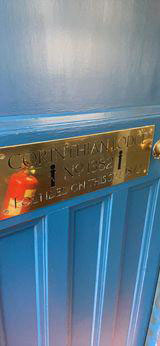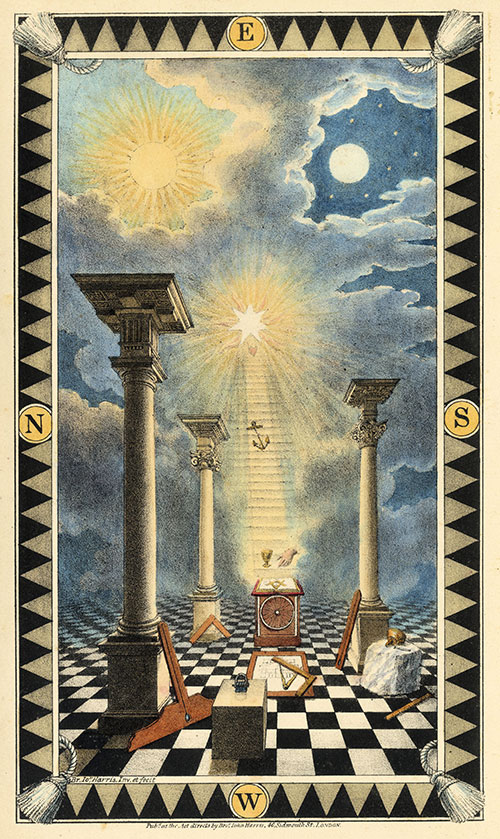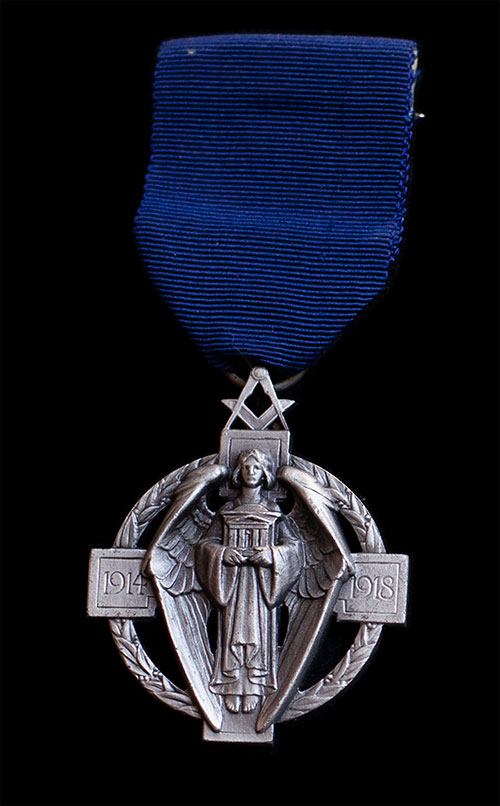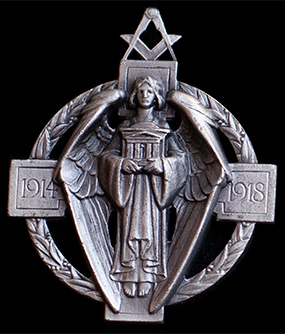CORINTHIAN LODGE No. 1382

Founded 1872 – Stability Ritual
Corinthian Lodge No 1382 was formed by members of Lodge of Temperance in the East No 898 and included in the petition to Grand Lodge was this plea “…and also for the convenience of Masters or Officers of ships lying in the Millwall Docks and the West India South Dock, there being no other Lodge in the immediate neighbourhood.” Though the Lodge was consecrated at the Silver Tavern, Burdett Road, Bow, by W. Bro. Henry Muggeridge, preceptor of the Stability Lodge of Instruction, on March 20th, 1872, it was empowered to meet on a regular basis at the George Inn, Glengall Road, Cubitt Town on the Isle of Dogs, on the third Wednesday in every month.
This photograph was taken in February 2022 by the current landlord of the George Inn, and it is at the entrance to the cellar where he believes the members went to conduct their meetings. What a lovely tribute to our founders, particularly to those members of Temperance in the East whose foresight and dedication made possible what we have today.

Most of the Founders were closely allied with the docks and its affiliated trades.
There appear to be no extant minutes from the early meetings but in 1883 the commencement of a charity fund was noted, and in 1884 the names of all the officers, brethren and visitors were recorded in the minute book for the first time! In 1889, for the first time, a printed summary of the balance sheet was presented to the Lodge, where the Initiation fees of ten guineas totalled £252. The Committee decided that refreshments for eight meetings in the year should consist only of sandwiches, beer, and spirits, that hock should be discontinued on quarterly nights and that malt liquor substituted and that no pastries be allowed.
In July 1895, an emergency meeting was held to decide what to do about members who were over five years in arrears. In 1897 new byelaws were framed with the Lodge to meet every month except for July and August.
In 1889, a proposal to exclude all members who were more than five years in arrears was passed unanimously resulting in forty-five brethren being excluded.
In 1902, a message from the Grand Secretary was read in open Lodge pointing out that the drinking the health of the newly installed Master in wine in the Lodge was contrary to Masonic propriety and that the proper place for such acknowledgements was at the banqueting table.
January 1906 saw the first Second degree Tracing Board Lecture delivered, and in September the Reigning Master delivered the Charge to the Initiate and the First Degree Tracing Board Lecture was delivered by a Past Master.

In 1907 it was unanimously decided not to support the forming of twelve Metropolitan Grand Lodges. (Corinthian Lodge was a Founding member of the Metropolitan Grand Lodge in 2003).
February 1909 saw the Lodge move to Three Nuns in Aldgate due to the increasing Lodge membership, and its first London Rank honour. In 1911 the first Ladies' Night was held and for which the guests’ tickets were priced at half a guinea.
In September 1911, Herbert Broughall Lipsham, Manager of Millwall Football Club was balloted for and subsequently Initiated. In 1916, in the midst of war, a proposal to limit the Lodge Membership to two hundred was held over for twelve months, and later in the year it was decided to limit the number of Initiates admitted at any one meeting to two and limiting the total number of Initiations to twelve a year.
Again, due to increasing numbers, in 1921 the Lodge moved to Hotel Cecil in the Strand, and in 1923 the Corinthian Chapter came in to being and was a founding Chapter of the Royal Masonic Hospital. (In our Centenary History book published in 1972, the Chapter had thirty-five members nearing its 50th Anniversary, though sadly it is no more).
In 1927 the Lodge was awarded the Hall Stone Jewel for its contribution of £1,853 to the Masonic Million Memorial for the building of Freemasons' Hall.

More moves for Corinthian as the Hotel Cecil in the Strand was demolished in 1930 and so the Rembrandt Hotel in Kensington was our new home. Well for a while it was, as in 1933 a unanimous vote agreed a move to Freemasons’ Hall, Great Queen Street and in 1934, an Installation was held there for the first time. A most important resolution was adopted at the September meeting in 1943, which was to change the Ritual from a purely verbal rite to a published version of the Stability Ritual (Muggeridge Working).
In 1947 it was agreed that a poignard, properly inscribed and engraved be presented to the Golden and Corinthian Lodge of Australia in recognition of their help and kind thoughts, having sent food parcels to all the Lodge Members. Though the sponsoring of a daughter Lodge was proposed 1n 1948, it met with little support and the idea was dropped.
In 1961 a new Lodge banner was presented, replacing the original 1903 version. (Subsequently damaged beyond economic repair in the flood at The Central London Masonic Centre, see below). The Roger Baker Memorial Fund, with the blessing of the family, funded a replacement dedicated on 9th November 2016 in the presence of his brother Graham and nephew David both of Duke of Edinburgh Lodge No. 1259. The Lodge's final meeting at Clerkenwell took place on 20th November 2013.
1963 saw the last remaining link with the Isle of Dogs severed, with the death of the last remaining Member to have been initiated at the George Inn and who had been a Corinthian for fifty-eight years.
R.W.Bro. Colonel Sir Cullum Welch, Bt. was the guest of honour at the Centenary Festival meeting held at Great Queen Street on May 17th, 1972. The second century of the Lodge saw its next move, this time to the newly acquired Old Sessions House in Clerkenwell, which was to be designated the Central London Masonic Centre. Corinthian Lodge was a prime mover in this and became a Founder Member Lodge and many of the brethren bought Debentures to ensure its success. The building was completed in 1782 as the Middlesex Sessions House, in the Grand Pantheon style, much favoured by George III, replacing the 1612 version called Hick’s Hall in St. John Street near Smithfield Market, where 29 regicides were tried and subsequently executed for their part in trying and executing Charles I. This building had a room where bodies of criminals were publicly dissected. Our building was extended in 1837 and again in 1860 as further court rooms were required to meet the increasing demand. This was the London Courthouse with the worst reputation for the harshness of its sentencing, where twenty years was not unknown for stealing a pair of boots. Prisoners for “Transportation” were herded in chains to Newgate Prison, from there they went via the Thames to America or Australia. A more local prison was Bridewell House of Correction in Clerkenwell Close (now the site of Mount Pleasant Sorting Office) that was so tough that the military refused to send its offending soldiers there.
Why such a busy court? Well, the area was a den of iniquity. The 1381 Peasants Revolt started here, and Wat Tyler was decapitated, and his head displayed on Clerkenwell Green. John Wilkes the radical politician was born here and when elected to Parliament and refused entry, because he was in prison following a duel, the citizens of Clerkenwell refused to vote in any other. (He was made a Freemason whilst in gaol by the members of Jerusalem Lodge meeting at the Jerusalem Tavern on the Green). Charles Dickens based Oliver Twist and the pickpocketing of the “Artful Dodger” here. Karl Marx lived at No 37 and saw the area as proof of what was wrong with capitalism. The Social Democratic League was formed here, and Lenin enjoyed its hospitality whilst living at No 16. William Cobbett campaigned here for the abolition of the Corn Laws from which grew the Chartist Movement that met regularly on the Green. Lord George Gordon in his 1778 campaign in Parliament to oppose the relief of Roman Catholics led a mob of 40,000 that for 6 days rampaged through prisons releasing prisoners and attacking Roman Catholic buildings. Dickens describes these scenes in “Barnaby Rudge.” Reginald and Ronald Kray gave Clerkenwell as their address when appearing before the Crown Court, and of course the Daily Worker now the Star, has been published here ever since; (Also the Guardian and Observer).
Though a wonderful venue and being included in the annual Open House event, snags were encountered and most, if not all, members decided to forgo any payments on their debentures and surrendered them to the Centre. The Centre became Grade II* listed in 1981 which brought greatly added expenditure, allied with less than perfect management, and with the twin disasters of fire and flood, the venture became untenable and so in 2013 Corinthian made its next move, just up the road in Lever Street, even further away from its roots.
However, within a year the financial problems that beset the Clerkenwell Centre, reared their ugly heads again, and so by the good offices of the Master, Secretary and John Stanion, a great stalwart of the Lodge, our next home was to be back east in Mumbai Square. Though not an ideal venue, it was only about 2 miles from our roots and the adjacent “Bell” proved to be a public house well suited to the East End. Having enjoyed prestigious meeting places for such a long time, Corinthian never felt quite right there, and when it was believed to be in danger of ceasing to be welcoming of Masonic Meetings it was decided to move to Mark Masons' Hall, which was situated in Mayfair!
Whilst Mark Masons' Hall was found to be of a similar venue to Clerkenwell, our initial intention had been to return to Freemasons' Hall. Thankfully, during the Covid 19 restrictions we were contacted by FMH with similar meeting dates, so we snapped up the offer. Our first meeting back at Freemasons' Hall took place in January 2022, our Installation in March which included our first new master for over 10 years, followed in quick succession by our 150th celebration. 2022 - a wonderful year to have not only a 150th but also two members present celebrating over 50 years in Freemasonry.
If you would like to see the 'family tree' of Corinthian Lodge, you can do so by clicking here.
If you would like to become part of our Lodge and assist us to help others, or if you are a Freemason and would like to attend one of our meetings as a visitor, then please get in touch.
| Email: | secretary@corinthianlodge1382.org.uk | |
| Tel: | 07478 690527 |  |


